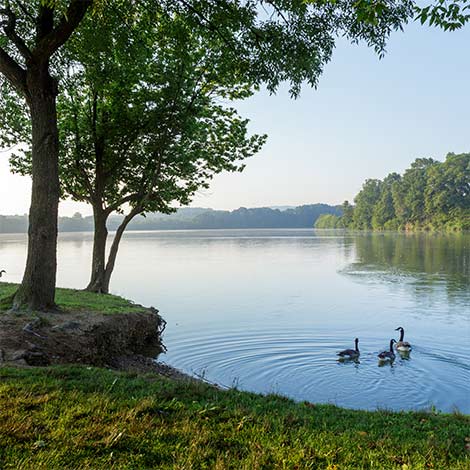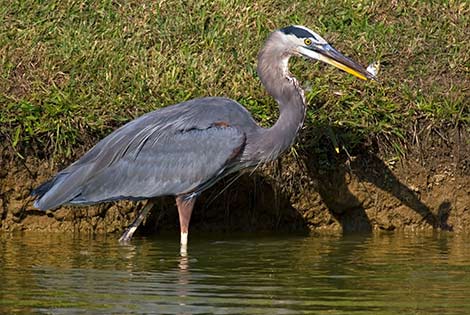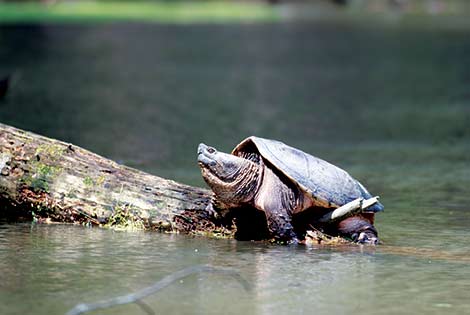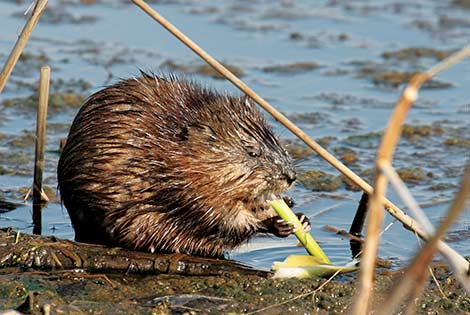Ponds attract all types of creatures to your pond, some more desirable than others. Muskrats, geese, snapping turtles, raccoons and herons may make a list of animals you do not want on your property. We will discuss different predator control strategies based on the type of animal you may want to keep at bay.
Herons
A common problem for pond owners is the great blue heron flying above looking for a bit of their favorite snacks: fish. There are many tools out there to to discourage heron from stopping at your pond:
- Use a heron decoy. Herons are territorial, and so if they see that another heron has claimed the pond, they will keep flying by. Pro tip: Avoid using heron decoys during mating season, which is generally April and May but may vary depending on your location. The decoy may actually attract birds looking for a mate.
- Startle them with water. For ponds smaller than 1200 sq. ft., a motion-activated sprayer can detect movement up to 40 feet away and spritzes the predator with water. They are designed to startle them and scare them away.
- Provide hiding places for your fish. Just in case a heron does find its way into your pond, give your fish a place to hide. Pond Dye can be used to shade your pond. Portions of submerged large-diameter pipe or beds of weeds work well, as does the addition or other fish habitat.
Muskrats & Snapping Turtles
Muskrats and snapping turtles, at times, can actually be a cool addition to your pond. It is fun to watch the muskrats swim around and sunbathe and snapping turtles can be amazing to look at if you can spot a large one moving around the shallow areas. These animals can also curb weed growth and balance fish populations in the pond. However, if you have a nice fountain display that is getting damaged from muskrats chewing on the power cords, or feel the turtles mistaking your toes for a nice snack, it may be time to ask them to leave.
- Disrupt The Habitat: Sometimes ridding your pond of muskrats is a simple as disrupting or removing their habitat. There are many tools available to aid in your quest for a weed-free pond that range from aquatic algaecides and herbicides, to rakes and cutters. Create a subtle wake by running an aeration system to annoy the muskrats and when possible, fill in or collapse any holes they dig as this can deter them from sticking around as well.
- Relocate: Once snapping turtles and muskrats have worn out their welcome you can help them find a new home by using live traps. Turtle traps can be baited with fish or meat and place in shallow areas of the pond with the top of the cage exposed, while muskrat traps can be baited with apples near their tunnels. Once you have them under lock and key, take them on a long trip and relocate them to a distant pond or lake.
Canadian Geese
The abundance of waste that is produced by geese can wreak havoc on your lawn and pond can be problematic to pond owners that want clear water to swim in. The best defense against geese is to place realistic decoys in and around your pond to prevent them from turning your property into their summer home.
- Swan Decoys: Plan ahead and be ready with a pair of floating swan decoys. Swans and geese naturally compete for a nesting space so if you place swan decoys in the pond as soon as the ice melts the geese will find a different nesting area.
- Coyote and Alligator Decoys: Geese prefer an open area near water so they can make a quick getaway in case a predator comes along. To discourage them from landing on your property by placing coyote or alligator decoys where they can be seen from the air and move them around every few days for a realistic appearance. The coyote decoy can protect open land for up to 1 acre, while the alligator decoys work near the shoreline or in water.
Raccoons
Though raccoons love to eat mice, insects, and tasty fruits and vegetables, the opportunistic water-loving critters will happily take a dive in your lake to hunt for crayfish, fish, turtles, frogs, and worms. They will use their lightning-fast paws to grab both aquatic and terrestrial prey.
Mother Nature provides her own raccoon control in the form of coyotes, foxes, great horned owls and bobcats, but you can give her a hand by keeping garbage cans sealed and using a live-animal trap baited with cat food or tuna to trap and relocate them. If that does not work you can trick raccoons using the
Nite Guard Solar deterrent. With solar-powered red LED Lights that are activated at dusk, the Nite Guard Solar resembles a predator's flashing eyes scaring away the raccoon.




